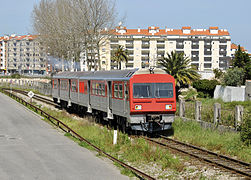CP series 9630
| CP series 9630 | |
|---|---|
|
Railcar (number 9635) of the type CP-9630
at the equipment transfer ramp in Aveiro station |
|
| Numbering: | 9631-9637 |
| Number: | 7th |
| Manufacturer: | Sorefame |
| Year of construction (s): | 1991 |
| Gauge : | 1000 mm ( meter gauge ) |
| Top speed: | 90 km / h |
| Installed capacity: | 319 kW (434 hp) |
| Power transmission: | ABB / Henschel |
| Operating mode: | diesel |
| Classes : | 1 |
The CP series 9630 , also known by the nickname Vouguinha , is a two-part diesel multiple unit series of the Comboios de Portugal . The series produced in 1991 is intended for the remaining meter-gauge traffic of the Portuguese railways and is now only used on the Linha do Vouga and Ramal de Aveiro .
history
At the end of the 1980s, the discontinuation of meter-gauge traffic in the Portuguese railway network was out of the question: The operated route network was more than 500 kilometers in length. The suburban line between Porto and Póvoa de Varzim was one of the busiest meter- gauge routes in Europe at the time. In order to meet the demand, the Portuguese state railway Caminhos de ferro Portugueses ordered seven new diesel multiple units from the Portuguese Sorefame . Above all, these were intended to reinforce the class 9600 railcars , built by Alsthom in 1971 .
The production took place in the Sorefame works in Amadora , the seven railcars went into operation in September 1991. The railcars were already structurally prepared for later electrification , as there were also plans to electrify the Portuens meter-gauge network. The railcars consist of two parts, each with a motor car and a trailer.
The railcars remained on the line until the Linha da Póvoa ceased to operate in 2001/2002. While this line was being rebuilt for the operation of the Metro do Porto , the railcars moved into the Vouga Valley , where they replaced the 9300 series . The railcars are still in service there (2014) on the Linha do Vouga and Ramal de Aveiro between Espinho and Aveiro . However, due to the financial problems of the infrastructure operator REFER and the associated low maintenance of the line, the railcars are far from being able to reach their maximum speed, in large parts a speed limit of 10 km / h applies.
Originally, it was planned to park the vehicles in 2008, and operation on the remaining route was to be maintained by the more cost-effective vehicles from the 9500 series . However, since the latter derailed during test drives, the CP waived the plans.
Web links
- Brief information on the CP series 9600/9630 (Portuguese)
- Flickr photo group for the two series 9600 and 9630 (no free images)
Individual evidence
- ↑ João Paulo Martins, Madalena Brion, Miguel de Sousa, Maurício Levy and Óscar Amorim: O Caminho de Ferro Revisitado . O Caminho de Ferro em Portugal de 1856 a 1996. Ed .: Caminhos de Ferro Portugueses. 1996, p. 66 (Portuguese).
- ↑ Automotoras Diesel de Via Estreita da Série 9630. Transportes XXI, accessed on 12 May 2014 (Portuguese).
- ↑ Noticias Ferrocarril (= Maquetren . Volume 1 , no. 6 ). Resistor, SA, Madrid, S. 53 (Spanish).
- ^ Carlos Cipriano: Velocidade limitada a 10 km / hora na Linha do Vouga. In: Público . October 31, 2013, accessed May 12, 2014 (Portuguese).
- ^ Carlos Cipriano: CP across pôr na Linha do Vouga automotoras consideradas inseguras por peritos. In: Público. April 15, 2013, accessed May 12, 2014 (Portuguese).
gallery
Vehicle 9365 at Aveiro station







